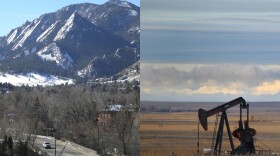At one point, the downtown was the cultural and business center of Greeley, Colorado. Over time though, the population moved west toward the mountains and I-25 - and businesses followed. A downtown development authority was formed in 1998 to stem the tide, to overcome the perception that the downtown was dead.
Now it appears that the city center is starting to turn that final corner of revitalization.
Pam Bricker, the executive director of Greeley's , has been working hard since 2010 to revitalize the city core, but it's not been easy.
"Well, it's all about timing," said Bricker. "And you know you have to be patient when you're developing a downtown."
After taking over management of the city's development authority, Bricker sought the help of Denver-based in crafting a long-term redevelopment . Now, it's clear that things are starting to change, said Bricker. But only after the area started adopting PUMA's suggestion of creating a live, work and play atmosphere.
"At some point you have to have that balance, so it's all not one way or the other," she said. "This use to be a lot more just about you know, offices as opposed to retail."
That concentration of office space versus bars, shops, hangouts and restaurants meant that after quitting time, the streets and sidewalks were nearly abandoned – a ghost town. Erica Heller of Progressive Urban Management Associates said that perception was hard to overcome.
"Fighting to try to convince them to change their attitude is a higher mountain to climb," she said.

Heller points out that task is being made easier now that Greeley's DDA is focusing on what she calls the "in-place market," otherwise known as the residents that live in the city core or travel there on a regular basis. She believes that if they are invested in their downtown, others will eventually follow.
Who else is a target market? How about the more than 11,000 students at nearby ?
Pam Bricker said that's exactly what the downtown has been doing.
"There was a time with our retailers and stuff that - I don't care how beautiful it was between here and the college - students wouldn't have been interested," Bricker said. "But now they have places to go. They have the , they have the , they have the and the other college bars that exist down here, and so they want to be down here."
Student interest coupled with a very inexpensive real estate market is partly what attracted restaurant owner Jake Fitzsimons to the heart of downtown.
"This entire building, which includes the offices upstairs, our new corporate offices is I think about 5,400 square feet. I bought the building for $260,000," Fitzsimons said of his latest location.
The perception of what Greeley's downtown was – compared to Old Town Square Fort Collins, where another of Fitzsimons' restaurants is located – nearly kept him from moving in.
"You know, they are two different beasts," he said. "I don't know if Greeley will ever be downtown Fort Collins, but it doesn't have to be. We get to a point where you're not talking about potential anymore, but we're talking about reality and I think we're there."
The outlook hasn't always been that rosy.
The economic downturn had a severe impact on implementing the PUMA plan as did the 2014 departure of . Pam Bricker said a grocery store was vitally important to developing the area between the university and downtown.
"You know we are now called a food desert," said Bricker. "And we're actually working with the Colorado Fresh Food program to come up with finding a location for some type of independent grocer. The large chains aren't looking at these kind of urban markets, it's not their thing."
Finding an independent market or grocer is just one of the top priorities for Bricker and the Greeley DDA. The other is jumpstarting development of a and conference center project - just two more pieces of the puzzle in redeveloping Greeley's downtown.








